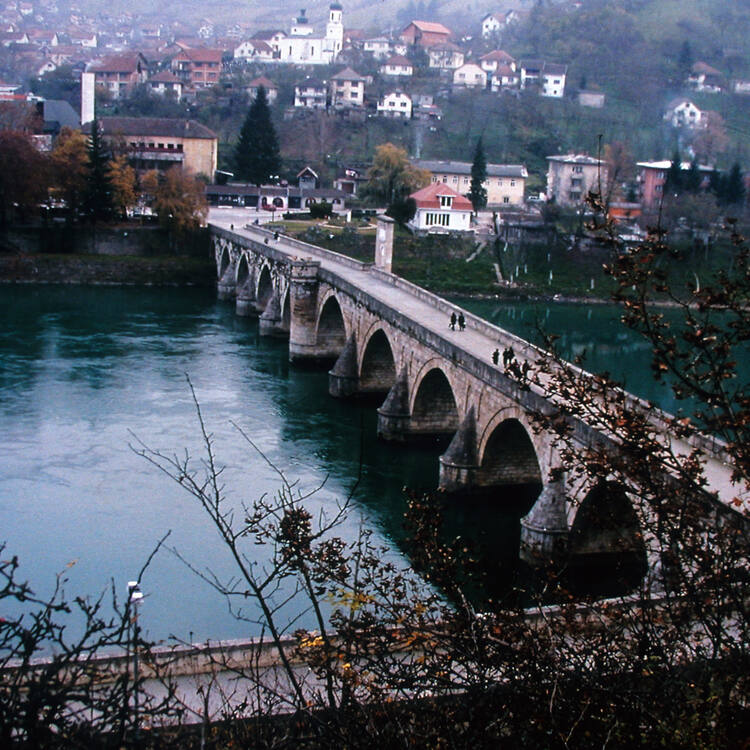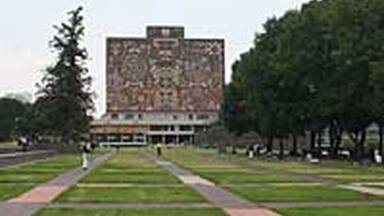Mehmed Paša Sokolović Bridge in Višegrad
Mehmed Paša Sokolović Bridge in Višegrad
The Mehmed Paša Sokolović Bridge of Višegrad across the Drina River in the east of Bosnia and Herzegovina was built at the end of the 16th century by the court architect Mimar Koca Sinan on the orders of Grand Vizier Mehmed Paša Sokolović. Characteristic of the apogee of Ottoman monumental architecture and civil engineering, the bridge has 11 masonry arches with spans of 11 m to 15 m, and an access ramp at right angles with four arches on the left bank of the river. The 179.5 m long bridge is a representative masterpiece of Sinan, one of the greatest architects and engineers of the classical Ottoman period and a contemporary of the Italian Renaissance, with which his work may be compared. The unique elegance of proportion and monumental nobility of the whole site bear witness to the greatness of this style of architecture.
Description is available under license CC-BY-SA IGO 3.0
Pont Mehmed Pacha Sokolović de Višegrad
Construit à la fin du XVIe siècle sur la rivière Drina, à l’est de la Bosnie-Herzégovine, le pont Mehmed Pacha Sokolović de Višegrad a été construit par Mimar Koca Sinan, l’architecte de la cour, sur ordre du grand vizir Mehmed Pacha Sokolović. Il est caractéristique de l’apogée de l’architecture monumentale et du génie civil ottomans. Il possède 11 arches maçonnées dont les ouvertures sont comprises entre 11 et 15 m, ainsi qu’une rampe d’accès à l’orthogonale de quatre arches sur la rive gauche de la rivière. Ce pont, long de 179,5 m, est une réalisation majeure de Sinan, un des plus grands architectes et ingénieurs du style ottoman classique et un contemporain de la Renaissance italienne, avec laquelle son travail peut être comparé. L’élégance de ses proportions et la noblesse monumentale uniques du bien témoignent de la grandeur de ce style d’architecture.
Description is available under license CC-BY-SA IGO 3.0
جسر محمد باشا سوكولوفيتش في فيشغراد
بني جسر محمد باشا سوكولوفيتش على نهر درينا في فيشغراد شرق البوسنة والهرسك أواخر القرن السادس عشر على يد رئيس معماريي السلطنة العثمانية معمار قوجه سنان، بطلب من الوزير الأعظم محمد باشا سوكولوفيتش. وهو يمثل ذروة الهندسة المعمارية والمدنية العثمانية. يتألف من 11 قنطرة معمارية يتراوح عرض فتحها بين 11 و 15 مترا، ومن رصيف متعامد مع أربع قناطر على الضفة اليسرى للنهر. يبلغ طول الجسر 179،5 متر، وهو من أبرز أعمال سنان، أكبر المعماريين والمهندسين المختصين في الطراز العثماني التقليدي، والذي واكب عصر النهضة الإيطالية ويمكن تشبيه أعماله بها. أبعاد الجسر الرشيقة وجزالة أسلوبه الفريدة تدلان على روعة ذلك النمط المعماري.
source: UNESCO/CPE
Description is available under license CC-BY-SA IGO 3.0
迈赫迈德•巴什•索科罗维奇的古桥
迈赫迈德·巴什·索科罗维奇的古桥横跨于波斯尼亚和黑塞哥维那东部的德里那河(Drina River)上,建于16世纪末,由宮廷建筑师思南(Sinan)在土耳其帝国的首相迈赫迈德·巴什·索科罗维奇(Mehmed Paša Sokolović)的命令下所建造。这是土耳其帝国纪念性建筑和土木工程的巅峰之作。大桥共有11个石拱,每个石拱跨度11至15米,右侧的入口斜坡有四个拱门,位于德里那河左岸,桥身长179.50米。它是土耳其和意大利文艺复兴时期最伟大的建筑师和工程师之一米玛尔·科卡·思南(Mimar Koca Sinan)的代表性杰作。这处遗产比例结构优美,气势宏伟壮观,见证了此类建筑风格的独特魅力。
source: UNESCO/CPE
Description is available under license CC-BY-SA IGO 3.0
Мост Мехмеда Паши Соколовича в Вышеграде
Мост Мехмеда Паши Соколовича в Вышеграде свидетельстует о расцвете монументальной архитектуры и инженерного мастерства Оттоманской империи. Он был построен в конце XVI века на реке Дрина в восточной части Боснии и Герцеговины придворным архитектором Мимаром Коса Синаном по приказу великого визиря Мехмеда Паши Соколовича. Он насчитывает 11 арок каменной кладки, размахом от 11 до 15 метров каждая, а также прямоугольный въезд с левого берега из четырех арок. Сооружение длиной 179,5 м – одно из лучших произведений Мимара Косы Синана, одного из крупнейших архитекторов Оттоманской империи, современника эпохи Итальянского Возрождения. Этот мост связан со многими фольклорными, литературными и художественными традициями.
source: UNESCO/CPE
Description is available under license CC-BY-SA IGO 3.0
Puente de Mehmed Pacha Sokolović en Visegrado
El puente de Visegrado fue construido sobre el río Drina a finales del siglo XVI por Mimar Koca Sinan, arquitecto del sultí¡n, por orden del gran visir Mehmed Sokolović. Es característico del periodo de apogeo de la arquitectura monumental y la ingeniería civil otomanas. Consta de 11 arcos de mampostería con aperturas de 11 a 15 metros, así como de una rampa de acceso de cuatro arcos en í¡ngulo recto, situada en la orilla izquierda del río. El puente de 179,5 metros de longitud es una obra destacada de uno de los mí¡s grandes arquitectos e ingenieros del periodo clí¡sico otomano, Sinan, contemporí¡neo de los renacentistas italianos y ejecutor de obras comparables a las de éstos. Las elegantes proporciones y la nobleza excepcional del puente en su conjunto atestiguan la grandeza de su estilo arquitectónico.
source: UNESCO/CPE
Description is available under license CC-BY-SA IGO 3.0
ヴィシェグラードのメフメド・パシャ・ソコロヴィッチ橋
メフメド・パシャ・ソコロヴィッチ橋は、ボスニア・ヘルツェゴビナ東部、ヴィシェグラードのドリナ川に架かるレンガ造りの橋。1577年に当時のヴィシェグラードを支配していたオスマン帝国の宰相の命で建設され、宰相の名がつけられた。11~15m径間の11アーチからなり、全長は179.5m。また、地盤が硬く架橋が困難だった左岸側では、橋は川岸で直角に折れ、四つのアーチをもつ120mの傾斜路で道路と結ばれた。オスマン帝国のもっとも偉大な宮廷建築家の一人といわれる、ミマル・シナンの手になるこの橋は、ルネサンス建築に比肩する均整のとれた上品さを見せ、オスマン帝国の建築水準の高さを伝えている。source: NFUAJ
Mehmed Paša Sokolović brug in Višegrad
De Mehmed Paša Sokolović brug over de Drina rivier in Višegrad werd eind 16e eeuw gebouwd door de hofarchitect Mimar Sinan Koca op bevel van de grootvizier Mehmed Paša Sokolović. De 179,5 meter lange brug is een meesterwerk van Sinan, een van de grootste architecten en ingenieurs van de klassieke Ottomaanse periode en een tijdgenoot van de Italiaanse Renaissance, waarmee zijn werk kan worden vergeleken. De brug heeft 11 gemetselde bogen met overspanningen van 11 tot 15 meter en een rechthoekige oprit met vier bogen op de linkeroever van de rivier. De brug en omgeving getuigen van een monumentale, maar elegante bouwstijl.
Source: unesco.nl
Outstanding Universal Value
The universal value of the bridge at Višegrad is unquestionable for all the historical reasons and in view of the architectural values it has. It represents a major stage in the history of civil engineering and bridge architecture, erected by one of the most celebrated builders of the Ottoman Empire.
The bridge particularly bears witness to the transmission and adaptation of techniques in the course of a long historical process. It also bears witness to important cultural exchanges between areas of different civilizations. It is an exceptional representative of Ottoman architecture and civil engineering at its classical apogee. Its symbolic role has been important through the course of history, and particularly in the many conflicts that took place in the 20th century. Its cultural value transcends both national and cultural borders.
Criterion (ii): Located in a position of geostrategic importance, the bridge bears witness to important cultural exchanges between the Balkans, the Ottoman Empire and the Mediterranean world, between Christianity and Islam, through the long course of history. The management of the bridge and repairs made it to have also involved different political and cultural powers: after the Ottomans came the Austro-Hungarians, the Yugoslav Federation, and the Republic of Bosnia and Herzegovina.
Criterion (iv): The Višegrad bridge is a remarkable architectural testimony to the apogee of the classical age of the Ottoman Empire, whose values and achievements mark an important stage in the history of humankind.
The property, principally consisting of the bridge, the access ramp and the two river banks upstream and downstream, is protected by its buffer zone on each bank of the Drina river. The integrity of the bridge is vulnerable but is now adequately protected by the buffer zone and appropriately expresses the values it embodies.
The Drina is a mountain river, drawing water from the mountains of the Balkans towards the Sava and the Danube Rivers. It is prone to flooding and the bridge parapets were destroyed in an exceptional flood in 1896. In addition, the bridge was severely damaged during both World Wars and, after temporary repairs, reconstructed in stone in the early 1950s.
Despite these historical events, authenticity has generally been maintained through the course of the bridge's successive restorations. It remains fragile, its foundations being particularly threatened by the use of the two hydro-electric power stations, one in Bosnia and one in Serbia, that affect the water levels of the river.
To allay this threat, the Serbian Ministry of Mines and Energy wrote to the Bosnian Commission to Preserve National Monuments on 27 June 2007. It supports the inscription of the bridge on the World Heritage List and also supports the formation of a bi-national working group to analyse the impact of power generation operations on the river in order to preserve the bridge. This initiative will complement the legal protection and management plan already in place.



